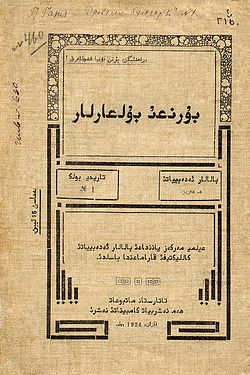
Back Аҭаҭар бызшәа Abkhazian Tartaars Afrikaans Татар тил ALT ታታርኛ Amharic اللغة التتارية Arabic تتارى ARZ Idioma tártaru AST Tatarava AVK Tatar dili Azerbaijani تاتار تورکجهسی AZB
This article should specify the language of its non-English content, using {{langx}}, {{transliteration}} for transliterated languages, and {{IPA}} for phonetic transcriptions, with an appropriate ISO 639 code. Wikipedia's multilingual support templates may also be used. (May 2019) |
| Tatar | |
|---|---|
| татар теле tatar tele تاتار تئلئ • تاتار تلی | |
 Tatar in Cyrillic, Latin, and Perso-Arabic scripts | |
| Region | Volga region |
| Ethnicity | Volga Tatars, Qaratays |
| Speakers | L1: 4 million (2020)[1] L2: 810,000 (2020)[1] |
Turkic
| |
Early form | |
| Dialects | |
| Tatar alphabet (Cyrillic, Latin, formerly Arabic) | |
| Official status | |
Official language in | Tatarstan (Russia) |
Recognised minority language in | |
| Regulated by | Institute of Language, Literature and Arts of the Academy of Sciences of the Republic of Tatarstan |
| Language codes | |
| ISO 639-1 | tt |
| ISO 639-2 | tat |
| ISO 639-3 | tat |
| Glottolog | tata1255 |
| Linguasphere | 44-AAB-be |
 | |
 Tatar is classified as Vulnerable by the UNESCO Atlas of the World's Languages in Danger [4] | |

Tatar (/ˈtɑːtər/ TAH-tər;[5] татар теле, tatar tele or татарча, tatarça) is a Turkic language spoken by the Volga Tatars mainly located in modern Tatarstan (European Russia), as well as Siberia. It should not be confused with Crimean Tatar or Siberian Tatar, which are closely related but belong to different subgroups of the Kipchak languages.
- ^ a b Tatar at Ethnologue (27th ed., 2024)

- ^ Ethnic Groups and Religious department, Fujian Provincial Government (13 September 2022). "少数民族的语言文字有哪些?". fujian.gov.cn (in Chinese). Retrieved 28 October 2022.
- ^ "ACT of 6 January 2005 on national and ethnic minorities and on the regional languages" (PDF). Archived from the original (PDF) on 5 December 2019.
- ^ "Tatar in Russian Federation | UNESCO WAL".
- ^ "Tatar". Merriam-Webster.com Dictionary. Merriam-Webster.
© MMXXIII Rich X Search. We shall prevail. All rights reserved. Rich X Search